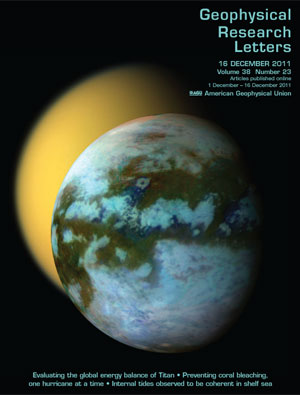Evaluating the Global Energy Balance of Titan
Work of UH’s Li, Smith and Jiang on Cover of Geophysical Research Letters
 Liming Li, Mark Smith and Xun Jiang were co-authors on a paper featured on the cover
of the December 16 issue of Geophysical Research Letters. The article published online
December 15.
Liming Li, Mark Smith and Xun Jiang were co-authors on a paper featured on the cover
of the December 16 issue of Geophysical Research Letters. The article published online
December 15.
Entitled, “The Global Energy Balance of Titan,” the authors studied the balance between energy coming in from solar radiation and thermal energy radiated back out of Titan, one of Saturn’s moons. Titan is the only moon in the solar system with a thick atmosphere, and scientists are investigating the ways in which it is similar to Earth.
This research presents the first observational evidence of the global energy balance on Titan, which will provide important clues for exploring Titan’s atmospheric system. Follow-up studies of more precise measurements of the global energy budget and its time variation will shed more light on the Titan’s atmospheric evolution and climate. This information will give researchers a better perspective to understand the climate change happening on Earth.
At University of Houston, Li is a research assistant professor and Jiang is an assistant professor in the Department of Earth and Atmospheric Sciences. Smith, dean of the UH College of Natural Sciences and Mathematics, is a professor in the Department of Chemistry and the Department of Earth and Atmospheric Sciences.
Other co-authors on the paper were from the California Institute of Technology, Jet Propulsion Laboratory, Cornell University, NASA Goddard Space Flight Center, and University of Maryland. The research was funded by the NASA Outer Planets Research Program.
Below is the Editors’ Highlight appearing online in Geophysical Research Letters:
To understand the weather and climate on Earth as well as on other planets and their
moons, scientists need to know the global energy balance, the balance between energy
coming in from solar radiation and thermal energy radiated back out of the planet.
The energy balance can provide interesting information about a planet. For instance,
Jupiter, Saturn, and Neptune emit more energy than they absorb, implying these planets
have an internal heat source. Earth, on the other hand, is in near equilibrium, with
energy coming in approximately equaling energy going out, though a small energy imbalance
can lead to global climate change. Saturn's moon Titan is the only moon in the solar
system with a thick atmosphere, and scientists have been interested in exploring ways
in which Titan is similar to Earth. To learn more about Titan, Li et al. (2011) calculated
its energy balance. The absorbed energy has been measured by various telescopes and
spacecraft; the emitted energy was recently measured by instruments onboard NASA's
Cassini spacecraft. The authors compared total absorbed solar power with total emitted
thermal power and found that the global energy budget of Titan is in equilibrium within
the measurement error.
- Kathy Major, College of Natural Sciences and Mathematics